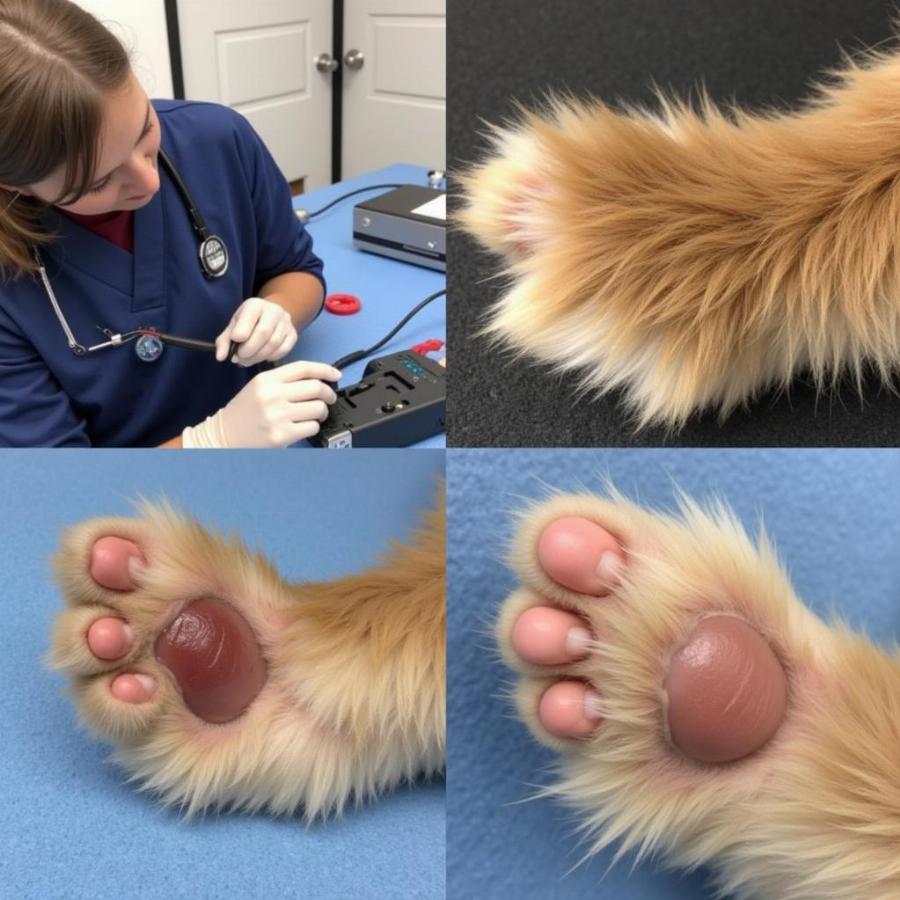Dog paw cysts are a relatively common issue that can cause discomfort and concern for pet owners. These abnormal, sac-like structures filled with fluid or semi-solid material can appear on a dog’s paw pads, between the toes, or on the top of the paw. Understanding the different types of dog paw cysts, their causes, and available treatment options is crucial for ensuring your furry friend’s well-being.
Types and Causes of Dog Paw Cysts
Several types of cysts can affect a dog’s paw. Interdigital cysts, often found between the toes, are among the most common. These can be caused by plugged hair follicles, foreign bodies, or infections. Another type is the synovial cyst, which develops near joints and is often associated with arthritis or joint injuries. Sebaceous cysts, filled with a cheesy substance, are less common on paws but can still occur. Trauma, inflammation, and even genetics can contribute to cyst formation.
What Does a Cyst on a Dog’s Paw Look Like?
Cysts on a dog’s paw often appear as small, raised bumps. They can be flesh-colored, red, or even dark. Some cysts might feel firm, while others are soft and fluctuant. The appearance can vary depending on the type of cyst and any associated inflammation or infection.
Why Does My Dog Have a Cyst on Its Paw?
As mentioned earlier, several factors can contribute to cyst development on a dog’s paw. These include follicular plugging, foreign bodies like grass seeds or splinters, infections, joint issues, and in some cases, a genetic predisposition. Identifying the underlying cause is essential for effective treatment.
Diagnosing and Treating Dog Paw Cysts
If you notice a lump or bump on your dog’s paw, it’s crucial to consult a veterinarian. While some cysts might be harmless, others can be painful or indicative of a more serious underlying condition. Your veterinarian will likely perform a physical examination and may recommend further diagnostic tests, such as fine-needle aspiration or biopsy, to confirm the diagnosis and determine the type of cyst.
How Are Dog Paw Cysts Treated?
Treatment options for dog paw cysts vary depending on the type, size, and location of the cyst. Some small, non-painful cysts may simply require monitoring. Others might benefit from medical management, such as anti-inflammatory medications or antibiotics if infection is present. Surgical removal is often recommended for larger cysts, recurring cysts, or those causing discomfort.
 Surgical Removal of a Dog Paw Cyst
Surgical Removal of a Dog Paw Cyst
Home Care and Prevention
While veterinary care is crucial for diagnosis and treatment, there are things you can do at home to support your dog’s recovery and potentially prevent future cysts. Keeping your dog’s paws clean and dry is important. Regularly checking your dog’s paws for any abnormalities, like cuts, abrasions, or foreign bodies, can help prevent infections and cyst formation. For dogs prone to interdigital cysts, regular trimming of the hair between the toes can also be beneficial. Similar to a swollen paw on dog, a cyst can cause discomfort.
How Can I Prevent My Dog from Getting Paw Cysts?
While not all cysts are preventable, taking proactive steps can significantly reduce the risk. Regular paw inspections, proper hygiene, and prompt treatment of any paw injuries are essential. If your dog is prone to interdigital cysts, discuss preventative measures with your veterinarian.
When to Seek Veterinary Attention
It’s crucial to seek veterinary attention if you notice any new lumps or bumps on your dog’s paw, even if they don’t seem to be bothering your dog. Early diagnosis and treatment can prevent complications and improve outcomes. If a cyst ruptures, becomes inflamed, or starts to bleed, immediate veterinary care is necessary. Just like with dog eye injury pictures, professional diagnosis is vital.
Conclusion
Dog paw cysts can be a source of worry for pet owners. Understanding the different types of cysts, their potential causes, and treatment options can empower you to provide the best possible care for your furry friend. Remember, early detection and veterinary intervention are key to successful management and a happier, healthier paw for your beloved companion. A dermoid in dogs might sometimes be mistaken for a cyst, highlighting the importance of a professional diagnosis. For cases similar to a bump on dogs nose, early attention can prevent serious issues.
FAQ
- Are all dog paw cysts cancerous? No, most dog paw cysts are benign (non-cancerous). However, it’s essential to have any new lump or bump checked by a veterinarian to rule out more serious conditions.
- Can I treat my dog’s paw cyst at home? It’s not recommended to treat a dog paw cyst at home without veterinary guidance. Attempting to drain or remove a cyst yourself can lead to infection or other complications.
- How much does it cost to remove a dog paw cyst? The cost of cyst removal varies depending on factors such as the size and location of the cyst, the complexity of the procedure, and your geographic location.
- How long does it take for a dog’s paw cyst to heal after surgery? Healing time typically ranges from two to four weeks, depending on the size of the cyst and the individual dog.
- Can dog paw cysts recur? Yes, some types of cysts, particularly interdigital cysts, can recur even after surgical removal.
Beaut Dogs is your trusted source for comprehensive information about dog breeds, care, and well-being. From understanding specific issues like dog paw cysts to general dog care, we’re here to provide expert advice and guidance. When you need support, contact us at Email: [email protected] for detailed and accurate answers from Beaut Dogs. Visit https://beautdogs.com to explore the wonderful world of dogs and learn how to care for them best.